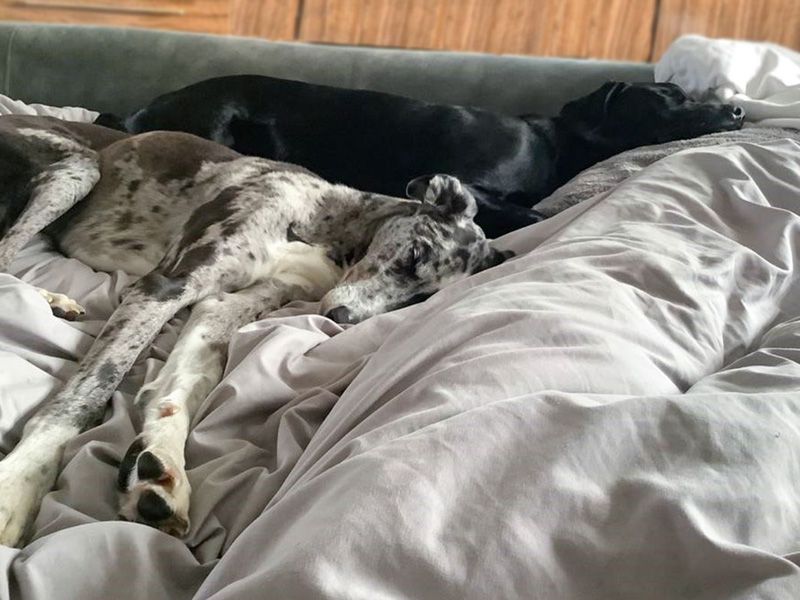Helping your dog get used to spending time alone
Find out how to prepare your dog for spending time alone so they can cope by themselves.

You want to ensure that your dog doesn’t struggle when you leave them home alone. Dogs are social and it’s not unusual for them to feel worried when they are left, especially for the first time. So, you need to teach your pooch how to spend time on their own and ensure they learn to feel relaxed by themselves.
Teaching a dog to cope when home alone should ideally start when they are still a puppy. It’s important to help prevent separation anxiety from developing, so the sooner you can prepare them, the better.
Is your dog already struggling to cope by themselves? Here’s what to do if your dog is showing signs of separation anxiety.
Teach your dog how to be alone
Before leaving your dog home alone, you need to teach them that it is alright and that they will be able to cope on their own. The more you do this before you actually need to leave the house, the easier it will be when you do.
Here are a few ways you can do that:
- make sure they have a comfy bed or build them a doggy den
- teach your dog to settle down calmly when you are busy, rather than giving them attention when they follow you around
- use baby gates across doorways to introduce time apart
- leave them with a long-lasting treat or toy that releases food
- slowly increase the time you leave them alone while you’re in the house
- start to build up the time you leave the house for
- factor some time apart into your daily routine.
It’s important to build up time apart very gradually and associate it with something positive, like a long-lasting treat. Monitor how your pup responds, and shorten the time left if they show any signs of anxiety.
It’s normal for dogs to want to be with us, but ultimately you want them to learn to enjoy being by themselves and to not follow you around and rely on your attention. That way, they will be able to cope better when you do leave the house and they are alone.

How to train your dog to be calm, relax and settle
Prepare your dog for being left home alone
Before you leave your dog at home, there are a few things you can do to help them feel calm and relaxed.
Take your dog for a long walk before you go out
Before you leave your dog alone, make sure they have been out for a long walk. This will give them a chance to burn off some energy, tire themselves out and go to the toilet. That way, they will hopefully be ready to settle down and sleep while you are out.
Make sure they have everything they need
Before you go out make sure your dog has access to water and their food or a long-lasting treat.
You could also leave an old item of clothing that smells like you in their bed – and don’t forget that doggy den, which will help make them feel safe and relaxed. Leaving …
Don’t make a fuss when you leave or return
You don’t want to make you leaving and returning to the house a big deal for your pooch. Make it as uneventful as possible so don’t make a big fuss of them.
Start by getting everything ready, so you can leave quickly and calmly. You could also use a word or phrase …
Don’t tell your dog off
Dogs develop separation anxiety because they are worried. Telling them off or being angry when they behave in a way that you don’t want is likely to make things worse.
If you come home and your dog has scratched up your floor or been to the toilet inside, they …
Don’t leave them on their own for too long
Dogs shouldn’t be left alone for more than four hours anyway. But if your dog is showing signs of separation anxiety then you should continue to build up to this gradually. If you do have to go out for longer, organise for someone to pop in or for your pooch to go to doggy …
Here are some of the most frequently asked to help your pooch prepare to be by themselves
What are the first signs of stress in a dog?
While teaching your pup that being on their own is alright, you’ll want to look out for behaviours that tell you if and when they are feeling stressed or worried. This could include:
- panting
- pacing
- yawning (unrelated to tiredness)
- lip-licking
- vocalising
- urinating
- destructive …
How long can you leave an adult dog alone?
At first, you should increase the time you are away from your dog very gradually. A few minutes is enough to start with. Once you have successfully built-up time apart, the length of time a dog can be left will depend on the individual. You should avoid leaving your dog for …
...What are the benefits of using a baby gate to help dogs get used to spending time alone?
A baby gate is beneficial as your pooch will still be able to see, hear and smell you without being with you or following you around. Before going through the baby gate, scatter some treats onto the floor or give your dog a chew or food-releasing toy to play with. This will …
...Contact our Behaviour Support Line
Need help with your dog’s training or behaviour? Contact our Behaviour Support Line for free expert advice.
Call us on 03030036666
or
Our free telephone service is open Monday to Friday 8.:30am to 7.:30pm and Saturday and bank holidays 9.:30am to 5pm.





